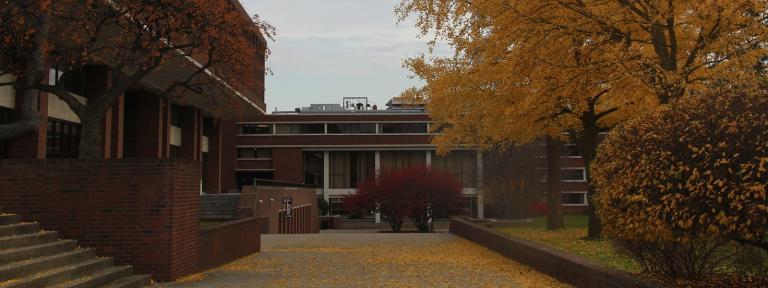
After lengthy planning and months of construction, the new Kearsley Street Corridor was unveiled Nov. 19 on the east side of the University of Michigan Flint campus.
While the street is not scheduled to be open to the public until after the Thanksgiving holiday, representatives from UM-Flint, the Flint Cultural Center, Kettering University, the City of Flint and the Genesee Regional Chamber of Commerce gathered to celebrate the nearly completed project. The event included short speeches and a ribbon-cutting ceremony, in which students from UM-Flint and Kettering participated.
Kettering President Stan Liberty and seniors Brian Benoy from Dallas, Texas, and Willy Joseph from Freeport, Bahamas, represented Kettering during the community event. “Kettering is pleased to be connected, pleased to be a partner in progress on this project,” Liberty said.
The 1,100-foot-long corridor runs east and west on Kearsley St., connecting the road between Wallenberg Street and Caesar Chavez Drive. The passageway serves as a link between Kettering University, downtown Flint, UM-Flint, the Flint Cultural Center campus, Mott Community College and the Applewood Estate, the home of the late C.S. and Ruth Mott, now operated by the Ruth Mott Foundation.
The project was funded by a nearly $1.9 million grant to the University of Michigan Flint from the Charles Stewart Mott Foundation.
The concept of reopening Kearsley Street dates back to the downtown and University of Michigan Flint strategic plans, which were completed in 2003 by Sasaki Associates, Inc., an interdisciplinary design firm based in Watertown, Mass.
“This new corridor is a major asset to the community,” said Tim Herman, CEO of the Genesee Regional Chamber of Commerce. “Not only does it link together the east and west sides of Flint, and the colleges, universities and cultural institutions, but the new Kearsley Street is symbolic of the road on which the Flint community is headed—a road that I am confident will continue to bring about positive change and development.”
Development includes extensive landscaping and seating areas, and accented crosswalks and bike lanes to help recognize the priority of non-motorized use along the corridor. LED street and pathway lighting is planned to provide proper visibility for safety and efficient energy use.
Three UM-Flint logos are embedded in the pavement along the corridor, one is the largest M-Flint logo visible on Google Earth. Vibration dampening measures are also planned if needed to protect research equipment housed in the William R. Murchie Science Building, located adjacent to the roadway.
Angelo Lafrate Construction, Inc., of Warren, was the contractor and Flint engineering firm Rowe Incorporated designed the corridor. Surveyors, engineers and landscape architects from Rowe, Inc., worked closely with UM-Flint staff to facilitate design and completion of the project.
Written by Pat Mroczek and GRCC sources
810.762-9533
pmroczek@kettering.edu